2017 Yamaha YZF-R1M Review
2017 Yamaha YZF-R1M on www.Totalmotorcycle.com
MOTOGP IS R WORLD…
Ever wish you could own a Yamaha Factory Racing M1? Your wish pretty much just came true.
Based on the championship winning R1, the incredible R1M is the pinnacle of Yamaha’s pure racing technology. It provides a riding experience like nothing before it. Power delivery is very linear and controllable with our comprehensive YRC electronic controls. Add in premium features including an Ohlins Electronic Racing Suspension, lightweight carbon fiber bodywork and our new Communication Control Unit that is both a data logger and data setting tool, and you have a machine that is destined to improve racing skills and results.
Yamaha YZF-R1M. We R1
The YZF-R1M motorcycle is a special version of the R1, and comes with an even higher factory specification – enabling every racer and track rider to discover their true potential.
A 6-axis Inertial Measurement Unit (IMU) offers controllability over traction, slides, front wheel lift, braking and launches. Its Communication Control Unit with GPS allows riders to look at lap times and other running data on a tablet – and the R1M’s Electronic Racing Suspension (ERS) delivers ultimate handling
With its 200PS crossplane engine, short wheelbase chassis, 3D control electronics and exclusive carbon bodywork, R1M brings M1-derived factory-bike technology to private owners.
///Suspension
The Yamaha R1M comes equipped with electronically adjustable, premium Ohlins “Electronic Racing Suspension” with 120 mm (4.7″) of wheel travel front & rear. Electronic Racing Suspension also further enhances the performance potential of the R1M with electronically controlled independent damping front & rear.
///Magnesium
Standard on the R1M are magnesium wheels, oil pan, cylinder head cover & crankcase covers. The lightweight design reduces unsprung weight & contributes to excellent suspension & handling performance.
///Electronic Rider Controls
The R1M has everything from a Launch Control System (LCS) to Slide Control System (SCS).Many of the rider assist aids are derived from Yamaha’s MotoGP race efforts and help make the R1M more controllable and enjoyable to ride.
2017 Yamaha YZF-R1M www.Totalmotorcycle.com Key Features
Cutting-edge MotoGP®-Derived Crossplane Crankshaft Engine
The YZF-R1M® features a lightweight and compact crossplane crankshaft, inline-four-cylinder, 998cc high output engine. Featuring a first ever for a production motorcycle, titanium fracture split connecting rods delivering extremely high horsepower and a strong pulse of linear torque for outstanding performance.
•Class-leading Electronics Package
The YZF-R1M features the most advanced MotoGP®-inspired electronics package ever offered on a supersport machine: a full suite of inter-related technologies, enabling the rider to enjoy the fullest range of performance with great comfort, control, and ease of operation.
•The Ultimate MotoGP®-derived Supersport
The YZF-R1M features an Öhlins® Electronic Racing Suspension (ERS), carbon fiber bodywork, and a Communication Control Unit (CCU) with GPS that enables the rider to capture ride data (including GPS tracking) and then download it via WiFi to the Yamaha Y-TRAC smartphone and tablet app. Once the data is downloaded, the rider can analyze it overlaid with the track map. Setting changes can then be made via the YRC Setting app and uploaded back to the R1M.
•MotoGP®-level Controllability
Featuring the first six-axis Inertial Measurement Unit (IMU) ever offered on a street-going motorcycle, the R1M represents the dawn of a new digital era where all riders can experience total 3D controllability.
•Informed Systems
IMU consists of a gyro sensor that measures pitch, roll, and yaw, as well as an accelerometer, or G-sensor, that measures acceleration in the fore-aft, up-down, and right-left directions… all at a rate of 125 calculations per second. By calculating each signal, the IMU finds the precise vehicle position and movement, and communicates it to the ECU, enabling it to control the bike’s systems.
•Digital Rider Aids
The R1M is fully equipped with banking-sensitive Traction Control, as well as Slide Control, Wheel Lift Control, Quickshifter, Launch Control, ABS, a Unified Braking System, and much more. The all-new R1M gives street riders, track day participants, and full-on racers an unmatched and unprecedented level of rider-adaptive performance.
•Deltabox® Frame
Advanced aluminum Deltabox® frame uses the engine as a stressed member of the chassis and is designed to provide the optimum balance of longitudinal, lateral and torsional rigidity.
•Titanium Exhaust System
A midship-layout exhaust system with titanium headers and muffler canister is positioned low and in the middle of the chassis for improved mass centralization.
•MotoGP® Styling
The styling on the new R1M is inspired by the YZR-M1, purposely sculpted for maximum aerodynamic efficiency.
2017 Yamaha YZF-R1M www.Totalmotorcycle.com Features and Benefits
///KEY DIFFERENCES between R1M & R1
• Premium Ohlins Electronic Racing Suspension (ERS)
• Communication Control Unit (CCU) – Data logger & vehicle info via Wi-Fi
• Wider 200 series rear tire (200/55ZR17)
• Carbon fiber front fender and fairing
• Polished & clear coated aluminum fuel tank (unpainted)
• Polished & clear coated aluminum swingarm (unpainted)
///Key Highlights
• Crossplane crankshaft, titanium “fracture split” con rods & offset cylinder
• Titanium intake & steel exhaust valves & special “Finger Follower” rocker arms
• Twin injector 45mm throttle body FI & new higher capacity air box
• Mid ship 4 into 2 into 1 exhaust system with EXUP & titanium header pipes & muffler
• Magnesium wheels, oil pan, cylinder head cover & crankcase covers
• Yamaha Ride Control: PWR / TCS / SCS / LIF / LCS / QSS/ CCU / SCU plus YCC-T & YCC-I
• Compact & lightweight aluminum Deltabox chassis & swingarm
• ABS & Unified Brake system, with dual 320mm front discs
• MotoGP M1 race bike inspired body design
• TFT multifunction instrument
• LED headlights, position lights & turn signals
///Engine
• Ultra-lightweight, compact, 998cc, DOHC, 16-valve (4-valves / cyl.), liquid-cooled, in-line four-cylinder engine with “crossplane” style crankshaft.
•The key components of this cutting edge engine design are the “crossplane” crankshaft and an uneven firing order. Both of these features are used on Yamaha’s race winning M1 MotoGP racer. The R1M crossplane crankshaft locates the center two rods at a 90 degree plane from the outer cylinders. Instead of the crank pins aligned on the same plane (a straight line drawn through
the center of the crankshaft), they align on 2 planes in the form of a cross … or “crossplane”. Working in conjunction with the crossplane crank is an uneven firing order. This R1M engine fires 1,3,2,4 cylinders and the firing intervals are uneven at 270 / 180/ 90 /180 degrees. What all this means to the rider is the most linear torque possible and amazing throttle control. This engine design allows a whole new level of rider – machine communication. One of the most important benefits is the outstanding cornering performance that increased engine / throttle control allows.
•The key engineering goal for the R1 series is significant horsepower with excellent controllability, making the bike easier & more enjoyable to ride. The R1M is a “rider’s machine”.
• 4-valve cylinder head design
•compact pent roof combustion chambers with 13:1 compression ratio
•lightweight 33 mm intake titanium valves & 26.5 mm steel exhaust valves
•4-valve design optimizes breathing efficiency & overall engine performance
•combustion chambers are machined to ensure exact volume spec for maximum power
•Special intake port shape provides maximum filling efficiency.
•port shape, valve placement & combustion chamber shape induce a tumbling effect of the inbound fuel – air charge that increases combustion speed, power & torque
• “Finger follower rocker arms”
•reduces friction, allows greater valve lift & provides super accurate control of valve opening & closing at high rpms
•sliding area of the rocker arms feature a DLC (diamond like coating) to reduce friction & wear
•valve adjustment pads sit under the rocker arm
• Valve adjustment intervals are every 42,000 kms.
• High performance intake & exhaust cams
• deck aluminum cylinder with “liner-less” ceramic composite plated cylinder bores.
•ceramic coating sprayed directly on the aluminum block, eliminating the liner & reducing weight
•excellent heat dissipation for consistent power delivery
•coating enhances the thin film of oil between the cylinder & piston, reducing friction & increasing power
• deck design allows cylinders to be spaced more closely together, reducing engine width
•cylinder is a stand-alone design (not integrated into the upper crank case)
• Offset cylinder design
•offsets cylinder block relative to the crankshaft (to the exhaust side) to reduce frictional losses between the piston and cylinder wall during the power stroke for improved power output
• Short skirt, forged aluminum pistons.
•light weight design for fast throttle response
•piston features a box shaped “bridge box ” on the underside for increased rigidity &
•durability
•special Defric coating on skirt to further reduce friction
•ring expansion tension is optimized to reduce frictional losses
•piston oil coolers spray oil at the underside of piston to reduce temperature
•Crossplane crankshaft design.
•crank inertial moment has been engineered to achieve linear throttle response, strong acceleration & excellent cornering exit control
•Super light, fracture split titanium connecting rods feature a “nutless” design.
•lower end “cap” of the rod is made from the same piece of material as the upper portion; the 2 pieces are “split” apart using a special process known as fracture splitting & then machined
•lightweight titanium design (60% lighter than a conventional steel con rod) reduces horsepower losses & provides faster throttle response
•fracture split “Ti” rods are a world’s first to be used on a production motorcycle
• Single axis balancer shaft
•reduces engine vibration
•Crankcases feature a “Tri-Axis” layout for the crank, main and drive axles.
•creates a more compact & shorter engine front to back
•shorter engine allows for optimum engine placement in the “sweet spot” of frame for desired weight distribution & great handling
• Closed loop, 45 mm Mikuni throttle body fuel injection system with twin injectors.
•twin injector (primary & secondary) system is used on our MotoGP M1 race bike, R1 & YZF-R6
•primary injectors are located in the throttle bodies, secondary injectors located in the air box very near the computer controlled intake funnels
•both primary & secondary injectors utilizes 12 spray holes to maximize fuel atomization
•secondary injectors, located inside the air box, begin to function at mid rpms to redline
• ” loop system” uses dual oxygen sensors to sniff spent exhaust gases & automatically adjusts the fuel / air ratio for reduced emissions
•fuel injection benefits include instant throttle response, choke-free starting, steady idle during warm up & reduced emissions
• Yamaha Chip Control Throttle (YCC-T)
•YCC-T electronically controls throttle valves for outstanding throttle response & controllability
•system features Throttle Position Sensor (TPS) and D.C. motor driven throttle valves
•YCC-T system provides precise control of intake air volume for a smoother torque curve
•ECU that controls YCC-T is capable of responding to changes at a speed of 1000th of a second
•Yamaha Chip Controlled Intake (YCC-I) system
•intake funnels / stacks vary in length between 2 pre-set positions depending on engine rpm
•electronic servo motor varies the funnels. The revolutionary YCC-I provides the best of both worlds… solid low rpm torque & power combined with an amazing high rpm rush. It takes only 0.3 of a second for the funnels to move from the tall to the short position
•Compact 6-speed transmission.
•features optimized gear ratios matched to engine output for maximum performance
•Compact, lightweight slipper or back limiter clutch assembly with assist.
•reduces rear wheel hop when making down shifts under hard braking
•key benefit is reduced lap times & smoother control when participating in a race or track day
•assist function reduces clutch lever effort
•Ram Air Induction System
•features centrally located intake duct between the LED headlights, delivering cool, “force-fed” air which pressures the air box & increases power output at higher speeds
•straight shot induction from centrally located fairing duct to air box without bends or turns
• Large capacity 10.5 litre air box
•large capacity maximizes performance
•M1 inspired intake duct with solenoid valve reduces intake noise & improves high rpm power
•viscous type, high flow air filter is used
•Mid ship design 4 into 2 into 1 exhaust system
•features lightweight titanium header pipes & muffler for reduced weight
•design maximizes power, reduces weight, centralizes mass & lowers the centre of gravity for fast, light, agile handling
•dual 3-way honeycomb catalyzers which reduce harmful exhaust emissions.
• Special exhaust valve device
•located in under engine chamber & features two separate exhaust flow routes based on rpm
•system allows a more compact muffler design that provides outstanding power output & torque characteristics while still providing sufficient silencing
•Yamaha’s EXUP System (Exhaust Ultimate Power Valve).
•part of the mid ship exhaust system
•utilizes a titanium body & butterfly valves that prevent the “blow back” phenomenon caused by “valve overlap”
•design reduces weight & maximizes cornering clearance
•EXUP system eliminates “flat spots” in the power band & reduces emissions too
•High-efficiency, high capacity curved radiator.
•curved rad provides more cooling surface area than a conventional flat rad
•ring-type fan provides increased airflow (and cooling) versus a standard cooling fan
• Air-cooled oil cooler sits below the main rad to maintain stable lubricant temperatures.
•Optimized wet sump lubrication system
•features special oil routing to the big end rod bearings
•lightweight, deep bottom magnesium oil pan significantly reduces weight
•convenient spin-on type oil filter is used.
•Super lightweight magnesium cylinder head & crankcase covers secured by aluminum bolts.
•magnesium offers significant weight savings
•Compact ACM (alternator) is mounted directly to the crankshaft.
•compact ACM uses rare earth magnets which produce more power for a given size than conventional magnets, therefore reducing size & weight
• Maintenance-free transistor controlled ignition (TCI).
•produces a strong spark for fast starts
•provides precise ignition timing / mapping for optimum engine performance at all rpms
•Direct ignition coils, iridium dual electrode spark plugs & high-output magneto.
•ignition coils integrated into plug caps, significantly reducing weight & complexity
///ELECTRONIC RIDER AIDS… YRC
Many of the following rider assist aids are derived from Yamaha’s MotoGP race efforts and help make the R1M more controllable & more enjoyable to ride. We call them Yamaha Ride Control or YRC.
•At the heart of the “Yamaha Ride Control” electronic rider assist aids are the IMU or Inertial Measurement Unit and ECU or Electronic Control Unit. The IMU features six axis of measurement using a gyro sensor to detect rotational motion in the pitch, roll & yaw directions. A “G”
sensor detects acceleration / velocity in the forward & back, up & down and left & right directions. The vehicle position information obtained from the two sensors including bank angle, pitch rate and sideways slide acceleration is sent to the ECU which in turn controls the five YRC systems (not including the quick shift system). These variables are calculated 125 times per second.
• PWR: Power Delivery Mode is Yamaha’s variable throttle control, which controls the throttle valve opening speed, enabling the rider to adjust performance characteristics of the engine based on riding preferences or conditions. There are 4-power settings available from an enhanced race setting to a slippery condition mode with softer power characteristics.
• TCS: Traction control system with lean angle sensor. System uses front & rear wheel sensors to detect slip and then adjusts / regulates power via the ECU / IMU to control rear wheel spin. In addition to detecting difference in speed between the front & rear wheels, system uses input on the degree of bank / lean angle to adjust the degree of TCS intervention to an optimum
level in relation to riding conditions in real-time. As the banking angle increases, the amount of TCS intervention also increases. When the TCS is disabled, SCS, LIF & LCS systems will automatically be shut down as well. There are 9 settings plus off.
•SCS: Slide Control System controls engine power when side slip is detected. Power output is adjusted to an optimum level to control side slide. There are 3 settings plus off.
•LIF: Lift Control System (a.k.a. anti-wheelie control) reduces time loss due to wheelies during closed course competition. System reduces front end lift during starts & hard acceleration. When the IMU and other sensors detect lift, engine output is adjusted to the optimum level to maintain strong acceleration without lift. There are 3 settings plus off.
•LCS: Launch Control System is adopted to help ensure fast, strong, controllable starts in closed course competition situations. When the LCS is activated, it keeps engine rpm limited to approx. 10,000 rpm and maintains an optimum level of engine power in conjunction with inputs from the TCS and LIF systems, allowing the rider to concentrate on clutch engagement and the other competitors, reducing stress associated with race starts. There are 2 settings plus off.
•QSS: Quick Shift System provides smooth, fast upshifts even at full throttle. When the switch on the shift lever rod detects motion, it adjusts engine output and momentarily cancels out the drive torque to promote faster gear shifts. There are 2 settings plus off.
•CCU: Communication Control Unit is a standard feature of the R1M; it will be sold as an accessory for base model. The CCU monitors / records various forms of machine information & simplifies set-up of the instrument panel’s function as a rider-machine “interface.” Comprised of the CCU & a GPS receiver, running data can be recorded via a data logger, and with the GPS function, the system also enables automatic lap time recording on race circuits. This data help racers / track day enthusiasts to improve their riding skills & lap times. By downloading an “app” for an Android or iOS based smartphones, it is also possible to create set-up data on a smartphone.Setting data can then be downloaded into the R1M via a Wi-Fi connection.
•SCU: Suspension Control Unit controls the electronic adjustments (front & rear) to the Ohlin’s “Electronic Racing Suspension”, available only on the R1M. There are 3 automatic setting modes and 3 manual setting modes.
///Chassis/Suspension
• Gravity cast, aluminum Deltabox frame
•designed to offer an optimized rigidity balance to maximize handling & suspension performance. Frame provides a balance of strength, rigidity & tuned flex
•engine is a stressed member with rigid mounts
•benefits include reduced weight, excellent high-speed stability & cornering characteristics, excellent traction / drive characteristics exiting a corner and a greater freedom in choosing or changing a line through a turn
•Detachable magnesium cast rear subframe
•reduces weight
•allows easier rear shock access & reduces costs in the event of damage
•Polished, lightweight aluminum “upward truss-type” swingarm
•provides great torsional rigidity for excellent rear wheel traction & control
•swingarm length is 570 mm
•design & length help reduce effects of chain tensioning during hard acceleration
•swingarm is polished aluminum & clear coated (not painted)
•Key chassis geometry figures:
•1405 mm wheelbase, 24 degree caster angle, 102 mm of trail
•56 degree maximum lean
• Electronically adjustable, premium Ohlins “Electronic Racing Suspension” with 120 mm (4.7″) of wheel travel front & rear.
•”ERS” further enhances the performance potential of the R1M with electronically controlled independent damping front & rear
•spring preload (front & rear) are set manually… 15 turns of front preload & 9 mm of threaded rear spring preload
•based on data from IMU & various sensors, the Suspension Control Unit (SCU) makes automatic, independent adjustments of both front & rear suspensions’ compression & rebound damping based on real time riding conditions
•SCU (suspension control unit) calculates the ideal damping for the front & rear suspensions
•ERS has a choice of “Automatic” or “Manual” modes. Within these 2 modes there is also a selection of 3-running modes each, for a total of six different settings to fit rider preferences or track conditions.
•Two of the “Automatic” modes have fine adjustment functions for damping force
•Manual mode cancels the semi – active damping & reverts to a “tune-able” traditional suspension with a significant adjustment range
•Electric steering damper
•ABS equipped, radial mount, 4-piston, mono-block calipers squeeze fully floating 320mm dual front discs.
•incredible braking performance with excellent control & lever feedback.
•radial mount design helps to reduce caliper distortion for improved braking performance
•Nissin radial master cylinder
•stainless steel mess brake lines
•6-position adjustable brake lever
•Single piston, slide-type Nissin rear caliper squeezes a lightweight 220mm disc.
•Front & rear brakes feature Yamaha’s latest anti-lock brake (ABS) & variable unified brake (UBS) technology.
•main benefit of ABS is excellent control under hard braking or braking on wet or slippery surfaces
•when ABS system senses impending wheel lock-up (via active type wheel sensors) it regulates the hydraulic brake pressure to the point just before the wheel(s) lock-up
•UBS system “unifies or links” the front & rear brakes when the front brake is applied
•applying the front brake will engage the UBS and to a varying degree will apply some rear brake force too. The amount of rear brake force is based on the attitude & lean angle of the bike.
•if only the rear brake is applied, the UBS will not apply any front wheel brake force
•Super lightweight, die cast magnesium 10-spoke mag wheels.
•over 1 kg of weight savings Vs. the ’14 wheels (last generation)
•lightweight design reduces unsprung weight & contributes to excellent suspension & handling performance
•front rim size is MT3.50 x 17, rear rim is MT6.00 x17
•R1M features a 200 series rear tire… 200/55ZR17
•Polished, lightweight, 17 litre aluminum fuel tank.
•tank provides excellent knee grip for hard braking & easy manoeuvrability
•elongated shape helps to centralize mass & reduces variance in riding feel as the fuel load (weight) changes
•3 litre reserve capacity (fuel trip meter activates)
•R1M tank is polished & clear coated (not painted)
•Super light, trick carbon fiber body work including front fender & fairing.
•wind tunnel designed windshield offers excellent aerodynamics & features a “screw less” design
•air resistance(fairing) has been reduced by 8% compared to ’14 model (last generation)
•LED headlights & high intensity LED position lights.
•create a “face” never seen before on a motorcycle & provides stylish & unique look for the R1
•excellent illumination & visibility
•reduced power consumption
•Fully digital instrument panel with TFT liquid crystal display.
•displays have been concentrated into a single 4.2-inch screen that adopts a fully transmissive Thin Film Transistor (TFT) liquid crystal display that reduces reflections & glare
•white or black backgrounds can be selected
•auto brightness adjustment based on available ambient light
•2-modes are available street & track
•street display mode functions include; speedo, bar style tach, odometer, dual trip meters, gear position, intake air temp, coolant temp, instant & average fuel efficiency, clock, fuel consumed, fuel trip meter (appears when fuel switches to reverse – 3 litres remaining), peak rpm indicator, front brake pressure indicator, acceleration indicator, lap timer, ERS indicator
& selected YRC setting info
•track mode functions include; race tach setting (tach starts at 8,000 rpm), lap number, lap timer (up to 40 laps), stop watch, gear position, speed & most of the above street displays including YRC setting info
•Immobilizer ignition system is designed to reduce the possibility of “ride away” theft.
•system must recognize the “coded ignition key” in order for the unit to start
•if the immobilizer ignition does not recognize the key, the ignition system & starter will not function, even if the ignition is forced into the on position
///Details
• LED front turn signals integrated into mirrors
• Compact, LED rear turn signals
• LED tail light
• 12 volt auxiliary DC connector (24 W / 2A)
• Large 25mm hollow front axle
• Extensive use of lightweight fasteners
• Oil level sight glass window
• Lightweight 525 series “O” ring drive chain.
• Low maintenance, lightweight, sealed battery (battery should be charged during winter storage)
NOTE: The YZF-R1M offers a significant level of power and performance. It is not intended for novice or inexperienced riders. All information is subject to change without notice.
2017 Yamaha YZF-R1M – www.Totalmotorcycle.com USA Specifications/Technical Details
US MSRP Price: 22,499 – Carbon Fiber Liquid Metal – Available from April, 2017
Engine Type 998cc, liquid-cooled inline 4 cylinder DOHC; 16 valves
Bore x Stroke 79.0mm x 50.9mm
Compression Ratio 13.0:1
Fuel Delivery Fuel Injection with YCC-T and YCC-I
Ignition TCI: Transistor Controlled Ignition
Transmission 6-speed w/multiplate slipper clutch
Final Drive O-ring chain
Suspension / Front 43mm Öhlins® electronic suspension w/inverted
fork; fully adjustable; 4.7-in travel
Suspension / Rear Öhlins® electronic suspension w/single shock; fully
adjustable; 4.7-in travel
Brakes / Front Dual 320mm hydraulic disc; 4-piston caliper,
Unified Brake System and ABS
Brakes / Rear 220mm disc; Unified Brake System and ABS
Tires / Front 120/70ZR17
Tires / Rear 200/55ZR17
L x W x H 80.9 in x 27.2 in x 45.3 in
Seat Height 33.9 in
Wheelbase 55.3 in
Rake (Caster Angle) 24.0°
Trail 4.0 in
Maximum Ground
Clearance
5.1 in
Fuel Capacity 4.5 gal
Fuel Economy** 34 mpg
Wet Weight*** 443 lb
Warranty 1 Year (Limited Factory Warranty)
Color Carbon Fiber Liquid Metal
2017 Yamaha YZF-R1M – www.Totalmotorcycle.com Canadian Specifications/Technical Details
Canada MSRP Price: $24,999 CDN
Engine
Liquid-cooled, DOHC, 16-valves (4-valves / cyl), in-line four
Displacement
998cc
Bore and Stroke
79 x 50.9mm
Compression Ratio
13:1
Maximum Torque
11.5 kg-m (83.2 ft-lbs.) @ 11,500 rpm
Engine Management
YCC-T, YCC-I, PWR, TCS, LCS, LIF, SCS, QSS, CCU & SCU
Fuel Delivery
Mikuni 45mm throttle body FI with twin injectors (primary & secondary)
Estimated Fuel Consumption±
14.4kpl / 40.6mpg (Imp.)
Lubrication
Wet sump
Ignition / Starting
TCI / Electric
Transmission
6-speed
Final Drive
520 series “O” ring chain
Suspension (Front)
Ohlins Electronic Racing Suspension (ERS) / 43mm inverted fork / 120 mm (4.7″) wheel travel
Suspension (Rear)
Ohlins Electronic Racing Suspension (ERS) – bottom link Monocross / 120 mm (4.7″) wheel travel
Brakes (Front)
Dual 320mm discs / radial mount, 4-piston calipers / ABS equipped & unified
Brakes (Rear)
220mm disc / single piston caliper / ABS equipped & unified
Tires (Front)
120/70ZR17
Tires (Rear)
200/55ZR17
Length
2,055 mm (80.9″)
Width
690 mm (27.2″)
Height
1,150 mm (45.3″)
Wheelbase
1,405mm (55.3″)
Rake / Trail
24° / 102mm
Ground Clearance
130 mm (5.1″)
Seat Height
860 mm (33.9″)
Fuel Capacity
17 litres (3.7 Imp. gal.)
Wet Weight
201 kg (443 lb)
Colour(s)
Carbon Fiber & Liquid Metal
2017 Yamaha YZF-R1M – www.Totalmotorcycle.com European Specifications/Technical Details
Europe/UK MSRP Price: £ See Dealer for Pricing in GBP (On The Road inc 20% Vat)
Engine
Engine type liquid-cooled, 4-stroke, DOHC, forward-inclined parallel 4-cylinder, 4-valves
Displacement 998cc
Bore x stroke 79.0 mm x 50.9 mm
Compression ratio 13.0 : 1
Maximum power 147.1 kW (200.0PS) @ 13,500 rpm
Limited power version N/A
Maximum torque 112.4 Nm (11.5 kg-m) @ 11,500 rpm
Lubrication system Wet sump
Clutch type Wet, Multiple Disc
Fuel system Fuel Injection
Ignition system TCI (digital)
Starter system Electric
Transmission system Constant Mesh, 6-speed
Final transmission Chain
Fuel consumption 7.2 l/100km
CO2 emission 168 g/km
Chassis
Frame Aluminium Deltabox
Front suspension system Telescopic forks, Ø 43 mm
Front travel 120 mm
Caster angle 24º
Trail 102 mm
Rear suspension system Swingarm, (link suspension)
Rear travel 120 mm
Front brake Hydraulic dual disc, Ø 320 mm
Rear brake Hydraulic single disc, Ø 220 mm
Front tyre 120/70 ZR17M/C (58W)
Rear tyre 200/55 ZR17M/C (78W)
Dimensions
Overall length 2,055 mm
Overall width 690 mm
Overall height 1,150 mm
Seat height 860 mm
Wheel base 1,405 mm
Minimum ground clearance 130 mm
Wet weight (including full oil and fuel tank) 200 kg
Fuel tank capacity 17 litres
Oil tank capacity 3.9 litres
Manufacturer Specifications and appearance are subject to change without prior notice on Total Motorcycle (TMW).


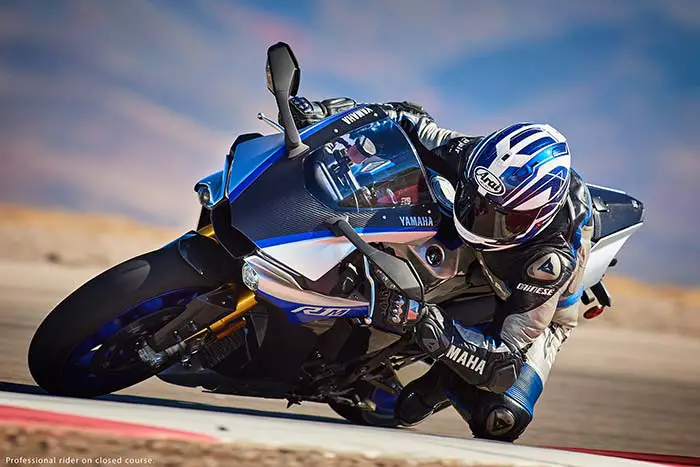
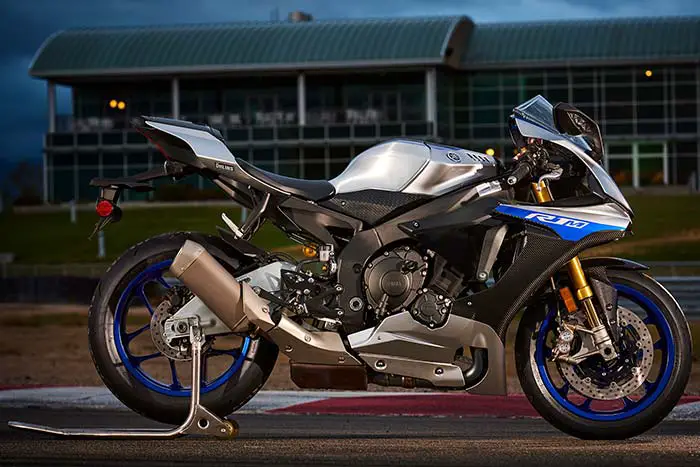
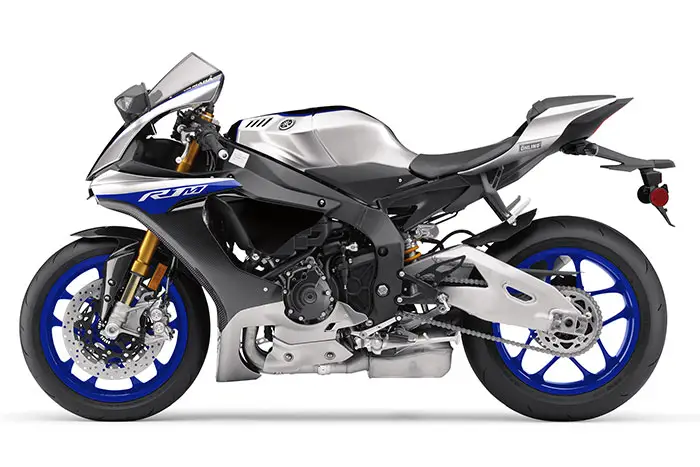
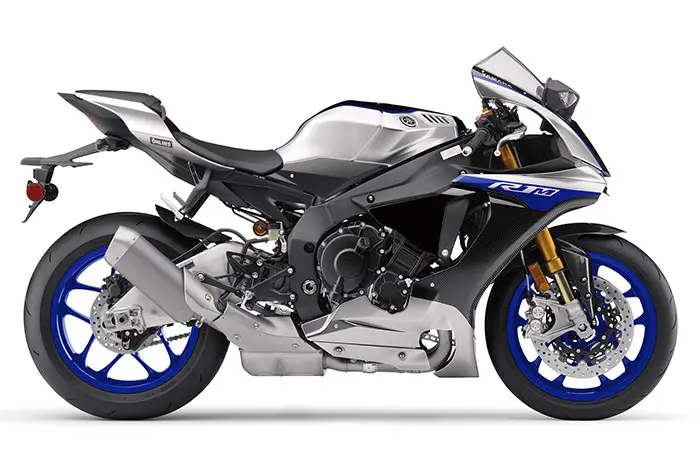
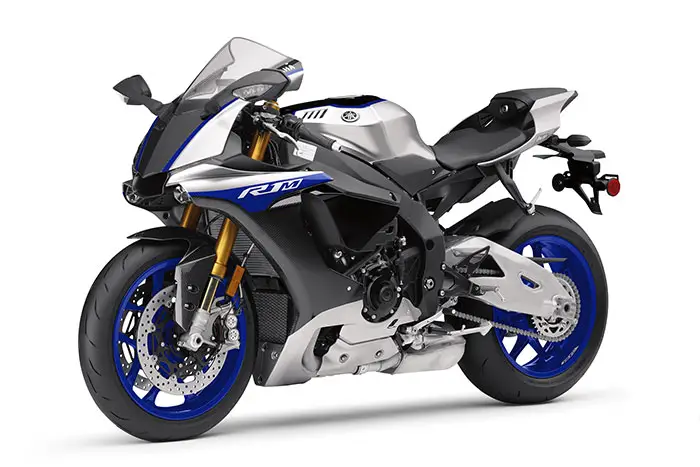

Be the first to comment